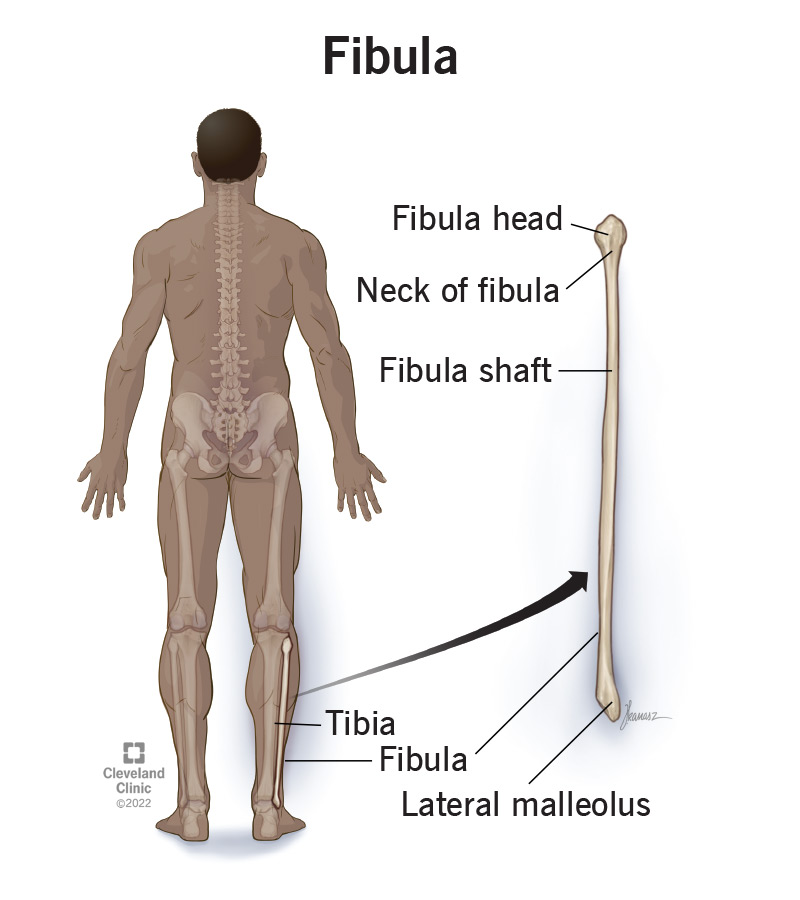The fibula is the third longest bone in your body. It isn’t weight-bearing, but it supports muscles, tendons and ligaments. If your bones are weakened by osteoporosis, you have an increased risk of fractures you might not even know about.
Advertisement
Cleveland Clinic is a non-profit academic medical center. Advertising on our site helps support our mission. We do not endorse non-Cleveland Clinic products or services. Policy

The fibula is your calf bone. It’s the smaller of the two bones in your lower leg. It gives your calf its structure and forms the top of your ankle. Your fibula also supports lots of important muscles, tendons, nerves and ligaments.
Advertisement
Cleveland Clinic is a non-profit academic medical center. Advertising on our site helps support our mission. We do not endorse non-Cleveland Clinic products or services. Policy
Because it’s not as strong as other bones in your leg like your femur (thigh bone) or tibia (shin bone), it’s more common to break your fibula. If you do experience a fracture, you might need surgery to repair your bone and physical therapy to help you regain your strength and ability to move.
Your fibula — like all bones — can be affected by osteoporosis.
The fibula and tibia are the two bones that form your lower leg.
The tibia is longer and forms part of your knee at its top (proximal) end and your ankle at its lower (distal) end. The tibia is weight-bearing, which means it supports your body when you stand and move.
The fibula is closer to the outside of your body (lateral) than the tibia. The fibula doesn’t support as much weight and mostly provides structure to your leg.
Your fibula has several important jobs, including:
The fibula is the smaller of the two bones in your lower leg. The other is the tibia. The fibula runs from just under your knee to your ankle. It’s closer to the outside of your body (lateral) than the tibia.
Advertisement
The fibula has a wedge-shaped end where it meets the tibia just below your knee, a long middle shaft and a notch at the bottom where it forms your ankle.
Even though it’s one long bone, your fibula is made up of several parts. These include:
The upper (proximal) end of your fibula meets the tibia and moves with it when you move your knee joint.
The shaft is the long portion of the fibula that forms the structure of your calf. It’s shaped like a three-sided prism.
The lower (distal) end of your fibula forms the top of your ankle joint. It meets your tibia and calcaneus (ankle bone).
All of these parts and labels are usually more for your healthcare provider to use as they describe where you’re having pain or issues. If you ever break your fibula — a fibular fracture — your provider might use some of these terms to describe where your bone was damaged.
The fibula is the third longest bone in your body. Only the femur and tibia are longer. Most adults’ fibulae (the plural for fibula) are around 14 inches long.
The most common issues that affect the fibula are fractures and osteoporosis.
A bone fracture is the medical term for breaking a bone. Symptoms of a fracture include:
The fibula is sometimes broken in a pattern that’s called an avulsion fracture. This happens when the muscles or ligaments attached to it are jerked or suddenly used. These breaks are also caused by hyperextended knees.
Go to the emergency room right away if you’ve experienced trauma or think you have a fracture.
Osteoporosis weakens bones, making them more susceptible to sudden and unexpected fractures. Many people don’t know they have osteoporosis until after it causes them to break a bone. There usually aren’t obvious symptoms.
Females and adults older than 50 have an increased risk for developing osteoporosis. Talk to your provider about a bone density screening that can catch osteoporosis before it causes a fracture.
The most common test done to check the health of your fibula is a bone density test. It’s sometimes called a DEXA or DXA scan. A bone density test measures how strong your bones are with low levels of X-rays. It’s a way to measure bone loss as you age.
If you’ve experienced a fibular fracture your provider or surgeon might need imaging tests, including:
Usually, your fibula won’t need treatment unless you’ve experienced a fracture or have been diagnosed with osteoporosis.
Advertisement
How your fracture is treated depends on which type it is and what caused it. You’ll need some form of immobilization — like a splint or cast — and might need surgery to realign (set) your bone to its correct position and secure it in place so it can heal.
Treatments for osteoporosis can include exercise, vitamin and mineral supplements and medications.
Exercise and taking supplements are usually all you’ll need to prevent osteoporosis. Your provider will help you develop a treatment plan that’s customized for you and your bone health.
Following a good eating and exercise plan and seeing your healthcare provider for regular checkups will help you maintain your bone (and overall) health. If you’re older than 50 or have a family history of osteoporosis, talk to you provider about a bone density scan.
Follow these general safety tips to reduce your risk of an injury:
Advertisement
Even if it doesn’t support your weight, the fibula is an important part of your leg. Anything you do to improve your overall health will also help keep your bones strong. Talk to your provider about your osteoporosis risk, and ask them about ways you can support your bones as you age.
Advertisement
From sudden injuries to chronic conditions, Cleveland Clinic’s orthopaedic providers can guide you through testing, treatment and beyond.

Last reviewed on 05/23/2022.
Learn more about the Health Library and our editorial process.